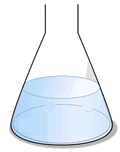|
A solution is an intimate mixture of a solute in a solvent. Solutions can be made by dissolving solids directly in liquids or by dilution of existing solutions. |
|
Primary standards
If we wish to make up a solution of known concentration, then the starting material must also be 'pure'. In reality, it is very difficult to obtain chemical compounds in a very pure state and, even if pure when bought, reaction with moisture or carbon dioxide in the air, light sensitivity or decomposion on standing can all reduce the level of purity.
Reactions in solution are often carried out for analytical and determination/estimation purposes. If the compound being used cannot be guaranteed to be pure, then it first must be standardised against a solution whose concentration can be determined to a high degree of accuracy. Such substances are called primary standards.
A suitable primary standards must have the following characteristics:
- obtainable in a pure state
- stable in the air
- readily soluble
- react with the reagents of choice
- high relative molecular mass
The high relative molecular mass is simpy to reduce percentage errors in the weighing stage.
| primary standards |
formula
|
relative mass
|
| sodium carbonate |
Na2CO3
|
105.99
|
| potassium hydrogen phthalate |
KHC8H4O4
|
204.23
|
| potassium hydrogen iodate |
KH(IO3)2
|
389.92
|
| potassium dichromate |
K2Cr2O7
|
294.19
|
Apparatus
In the laboratory, specially designed pieces of glassware are used to ensure accuracy, when dealing with solutions. These are:
- Pipette
- Burette
- Volumetric (graduated) flask
A pipette is used in conjunction with a pipette filler. The filler draws the solution into the glassware by means of suction, until the liquid reaches the correct level, indicated by a small circular line etched (drawn) around the upper thin part of the pipette. The pipette is emptied by allowing the liquid to run freely into its final receptacle and then, when it has all drained out, touching the tip of the pipette on the surface of the liquid to allow the surface tension of the aqueous liquid surface to remove the final part.
The volumetric flask also has a circle around the upper narrow part of the flask and when the lower part of the liquid meniscus is level with the line, the volumetric flask holds the correct amount.
|
Pipette
|
Sizes usually available
|
Volumetric flask (also called
a graduated flask)
|
Sizes usually available
|
|
|
5cm3 10cm3 25cm3 50cm3 |
5cm3 10cm3 25cm3 50cm3 100cm3 250cm3 500cm3 1000cm3 2000cm3 |
Procedure
| 1. The desired quantity of solute is weighed out on an accurate balance. |  |
2. This is then dissolved in a small quantity of water
and the solution transferred to the volumetric flask.
|
 |
| 3. Any remaining drops are rinsed into the volumetric flask using distilled water taking care to avoid splashing or spillage. |
 |
4. The volumetric flask is then filled up to the mark using distilled water. The solution is then shaken well by repeatedly inverting the flask. |
 |
|
Example: To prepare 250cm3 of 0.1M sodium hydroxide solution. 0.1 M means that 1 litre of solution contains 0.1 moles of solute. The solute in this case is sodium hydroxide. Sodium hydroxide has a relative formula mass of 40 (Na=23, O=16, H=1). 1 mole of NaOH = 40g therefore 0.1 moles of NaOH = 4.0g However, we don't require 1 litre (1000cm3) of solution, only 250cm3 therefore the mass of sodium hydroxide needed = 250/1000 x 4.0g = 1.0g |
Dilution
A calculated quantity of solution is transferred into a graduated (volumetric) flask using a pipette.
The flask is filled up to the mark using distilled water.
|
Example: To prepare 250cm3 of 0.1 mol dm-3 hydrochloric acid using 2.0 mol dm-3 standardised acid. In this case it is better to proceed by calculating the number of moles required in the final solution. Then, the volume of standardised solution that contains this number of moles can be calculated. Final solution required: 250cm3 of 0.1 M hydrochloric acid Moles = molarity x volume (litres) This contains 0.1 x 0.25 moles of HCl = 0.025 moles We wish to obtain 0.025 moles from the 2.0 M solution volume (litres) = moles/molarity Volume = 0.025/2 = 0.0125 dm3 Volume required = 12.5 cm3 Procedure: Measure 12.5cm3 of the standardised 2.0 M HCl into a volumetric flask using a burette. Add distilled water up to the mark mixing carefully. |


